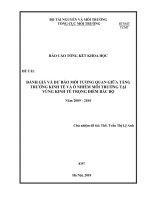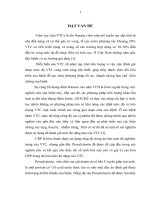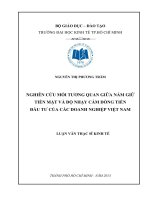DSpace at VNU: Về mối tương quan giữa trình độ học vấn và phát triển (Nhìn từ góc độ xóa đói giảm nghèo)
Bạn đang xem bản rút gọn của tài liệu. Xem và tải ngay bản đầy đủ của tài liệu tại đây (47.34 KB, 2 trang )
VỀ MỐI TƯƠNG QUAN GIỮA TRÌNH ĐỘ HỌC VẤN VÀ PHÁT TRIỂN
(NHÌN TỪ GÓC ĐỘ XÓA ĐÓI GIẢM NGHÈO)
GS.TS. Ngô Văn Lệ
Trường ĐH KHXH&NV, ĐHQG Tp HCM
Abstract
In recent years, together with socio-political organizations, Vietnam
Communist Party and the Government have a lot of efforts in poverty
reduction, especially in disadvantaged areas (mountainous, remote areas)
where the ethnic groups live. But, poverty reduction, in terms of efficiency is
still low and limited. The causes of poverty in Vietnam are very different and
depend on natural conditions, population of ethnic regions. The most popular
causes are as the followings: a, Climate conditions, natural disasters such as
floods, droughts; lacks of transportation; b, Lack of knowledge and finance,
population rapids, lack of labors, underemployment and social vices (drug
addiction, alcoholism, gambling ); c, The limitations of policies in investment,
agriculture, forestry and fisheries, etc. In addition to the common causes, the
poverty in ethnic group regions are caused by limited cognitive abilities
leading to be difficult to access new socio-economic services; by population
growth as well as the lack of plan spend.
Poverty has great influences on the development of ethnic groups and
has close relation to education level. So, what is the correlation between
education level and poverty reduction in ethnic minority areas? The data that
are collected (mainly in the Mekong delta, where a large concentration of
Khmer) in the process of implementation of projects in some areas of the
South and Highlands may clarify this correlation.
Trong những năm qua Đảng và Nhà nước Việt Nam cùng với các tổ chức chính trị
xã hội khác,đã có nhiều nỗ lực trong công tác xóa đói giảm nghèo, nhất là ở những
vùng khó khăn (vùng núi,vùng sâu,vùng xa) nơi các tộc người thiểu số sinh
sống.Tuy nhiên, công tác xóa đói giảm nghèo,nếu xét về hiệu quả thì vẫn thấp và
còn nhiều hạn chế,bất cập.Nguyên nhân của đói nghèo ở Việt Nam là rất đa
dạng.Tùy điều kiện tự nhiên,dân cư cụ thể mà các nguyên nhân đói nghèo không
giống nhau giữa các vùng.Ở vùng tộc người thiểu số sinh sống,tồn tại tất cả các
nguyên nhân dẫn đến đói nghèo trong cả nước.Nguyên nhân dẫn đến đói nghèo ở
Việt Nam bao gồm các nhóm khác nhau.Đó là nhóm nguyên nhân a) do điều kiện tự
nhiên như khí hậu khắc nghiệt,thiên tai,bão lụt,hạn hán,địa hình phức tạp,giao thông
khó khăn; do hạn chế chủ quan của người dân như thiếu kiến thức làm ăn,thiếu vốn
sản xuất,đông con,thiếu lao động,thiếu việc làm,lười lao động,mắc các tệ nạn xã hội
( nghiện hút,rượu che,cờ bạc); c) do cơ chế chính sách như thiếu hoặc không đồng
bộ về chính sách đầu tư,về khuyến nông, lâm, ngư, về vốn tín dụng … Đói nghèo ở
các tộc người thiểu số,ngoài những nguyên nhân chung còn có những nguyên nhân
có tính dặc thù.Đó là, do khả năng nhận thức hạn chế, dẫn đến khó tiếp cận các dịch
vụ kinh tế xã hội mới. Sự gia tăng dân số quá mức cho phép theo cả hai hướng tự
nhiên và cơ học là áp lực đến thiếu đất nông nghiệp.Mặt khác,môi trường xuống
cấp,dẫn đến điều kiện sống và sản xuất ngày một khó khăn hơn.Ngoài ra,tập quán
chi tiêu thiếu kế hoạch cũng là một nguyên nhân dẫn đến đói nghèo ở vùng các tộc
thiểu số.Đói nghèo lại có ảnh hưởng rất lớn đến sự phát triển của một tộc người.Mà
đói nghèo lại có liên quan đến trình độ học vấn .Vậy mối tương quan giữa trình độ
học vấn và vấn đề xóa đói giảm nghèo có mối liện hệ như thế nào đối với sự phát
triển và phát triển ở vùng các tộc người thiểu số ? Bài viết của chúng tôi,trên cơ sở
những tư liệu thu thập được (chủ yếu tại đồng bằng sông Cửu Long,nơi tập trung
đông đảo người Khmer) trong quá trình thực hiện các đề tài nghiên cứu khoa học tại
một số địa bàn Nam Bộ và Tây Nguyên làm rõ mối tương quan giữa trình độ học
vấn với phát triển và phát triển bền vững nhìn từ góc độ xóa đói giảm nghèo tại các
địa phương,nơi có nhiều tộc người thiểu số sinh sống.









